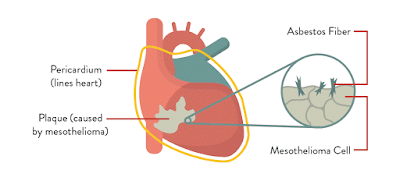 |
| Image: mesotheliom.com |
What is pericardial mesothelioma?
Pericardial mesothelioma is a serious heart condition which consists of cancerous cells building up on the lining of the heart. Similarly to pleural and peritoneal mesothelioma, this is a terminal illness due to the importance of the area on which it grows.
What causes pericardial mesothelioma and who are most at risk?
The primary cause of pericardial mesothelioma is exposure to asbestos dust and fibers. Therefore those at risk are those who are most likely to have inhaled these deadly fibers such as construction workers and asbestos manufacturers. Those in contact with these people also have a chance of getting pericardial mesothelioma because these people may have asbestos fibers stuck to their clothes or hair.
What are the symptoms of pericardial mesothelioma?
The symptoms of pericardial mesothelioma change from patient to patient. Usual symptoms include persistent coughing, coughing up blood, shortness of breath, chest pain and palpitations. Other symptoms patients may experience are nausea, weight loss, vomiting and loss of appetite.
What are the treatments available for pericardial mesothelioma?
There are various different treatments for pericardial mesothelioma although none of these have a high success rate. Chemotherapy, radiation therapy, dual therapy, and surgery are the treatment methods available. Chemotherapy includes using drugs to kill off cancerous cells and radiation therapy uses doses of radiation to kill cancer cells although this is difficult in the case of pericardial mesothelioma due to the surrounding vital organs such as the heart and lungs. Dual therapy is a treatment combining radiation therapy with chemotherapy. Surgery comes in two forms; aggressive surgery and palliative procedures. Aggressive surgery is a very difficult procedure and consists of removing large chunks of cancerous cells in an attempt to gain long-term control over cancer. Palliative procedures just attempt to lessen the symptoms for the patient.
How much is exposure to asbestos needed for there to be a possibility of getting pericardial mesothelioma?
This depends on how strong and resistant the person is to disease and on the concentration of asbestos in the environment around him. It is possible to get pericardial mesothelioma from as little as a couple of months of exposure to asbestos although on average it would take a couple of years for enough asbestos fibers to build up to cause cancer.
What is the prognosis for pericardial mesothelioma?
This is highly dependent on how early and how aggressively the cancer is treated. If pericardial mesothelioma is treated when it has fully developed and matured then the chances of a patient's survival is very small. The prognosis could be only a couple of months.
Is there any promising research into cures for pericardial mesothelioma?
Research into cures of pericardial mesothelioma and all other forms of mesothelioma is being done in numerous research labs all over the USA. Many pharmaceutical companies are also working hard to research new drugs for chemotherapy. So far, research has been mostly unsuccessful.
Comments
Post a Comment